Access to Telecommunications for All

Connectivity is the lifeblood of the modern digital era. Telecommunications services such as internet access and mobile connectivity are fundamental pathways leading to vast informational resources, economic opportunities, social interactions, and emergency services. However, a significant portion of the population for whom these services are out of reach remains due to a lack of infrastructure or financial constraints. To counter this imbalance and ensure that the benefits of telecommunications can reach everyone, significant strides have been made by both public and private endeavors. Such programs are essential steps toward bridging the digital divide and ensuring that all members of society can benefit from the digital revolution.
The push for digital inclusion is not merely a question of internet access; it is about ensuring the digital literacy that allows individuals to make the most of the online world for education, health care, or economic activities. Federal programs are at the forefront of this effort, providing a safety net for those left behind due to financial constraints. In an increasingly digitalized society, being connected is not merely a convenience—it forms the basis of empowerment and catalyzes participation in today’s digital economy. Universal telecom access is a powerful enabler of social inclusion and equitable progress.
Enhancing telecommunication access has a ripple effect across society. It empowers individuals with the tools needed to navigate and harness the power of digital technologies for learning, collaborating, and contributing to their communities and the wider world. By facilitating these connections, we lay the groundwork for a more inclusive and informed society capable of engaging with the challenges and opportunities of the 21st century.
Government Initiatives and Funding for Telecommunication Accessibility
Access to telecommunications has been recognized as crucial by governments worldwide, leading to developing strategies to make digital services available to all, regardless of economic status. In the United States, several programs have been implemented to provide equitable access to telecommunications services. These federally funded initiatives, often offered through collaborations with telecom providers, support various services, from mobile phone access to high-speed internet connections. Such initiatives are vital in ensuring that the digital divide does not widen but becomes a junction where all paths merge, granting universal access to information, communication, and opportunity. One example is the provision of free government phones in Arkansas, which grants eligible residents connectivity that they may not otherwise afford.
These policies aim to level the playing field, allowing everyone to engage with the digital world. Thus, individuals from low-income families, seniors on limited pensions, and even college students struggling with expenses are given a lifeline—the chance to connect online, which can be crucial for job searching, further education, and staying in touch with loved ones. For a more in-depth look at these telecommunication policies and their coverage, the Federal Communications Commission’s website offers an overview and updates on the initiatives and policies designed to support telecommunications accessibility.
The critical nature of government-led funding and initiatives in the landscape of telecommunications accessibility cannot be understated. By dedicating resources to expanding digital infrastructure and subsidizing telecommunication services for those in need, the government acts as a cornerstone in providing every citizen with the means to connect.
Technological Advancements and Their Role in Telecommunication
The telecommunication landscape is continually reshaped by technological advancements, which have brought remarkable changes to how we connect and communicate. These innovations, from introducing 5G wireless technologies to deploying advanced satellite communications, promise to deliver high-speed Internet to even the most challenging and remote locations. Such pioneering developments have the potential to significantly level the playing field, allowing more people to enjoy the benefits of fast and reliable internet services.
Furthermore, ongoing research and innovation in telecommunications could pave the way for emerging technologies such as low-earth orbit (LEO) satellites, which could provide global coverage and overcome many of the current limitations of terrestrial network infrastructure. As these technologies mature and become part of our daily lives, they offer hope for closing the connectivity gaps that remain challenging today.
Keeping abreast of these advancements is vital for individuals and businesses alike to fully grasp the potential impact on their lives and operations. For the latest technology news and how it influences the world of telecommunications, resources like Wired provide insightful commentary and analysis on the developments shaping the future of connectivity.
Understanding Eligibility for Subsidized Telecommunication Services
Qualifying for subsidized telecommunication services can make a considerable difference for individuals and families on a tight budget. The first step towards obtaining these services is understanding the eligibility requirements, which often include having an income level below a predetermined threshold or participation in existing federal programs such as the Supplemental Nutrition Assistance Program (SNAP) or Social Security. With these criteria in place, a safety net is provided to ensure that those who need communication services the most can easily avail themselves of this support.
Once eligibility is determined, the application process is designed to be straightforward, ensuring that complex procedures maintain the path to connectivity. This approach ensures that the very people for whom the program is designed—the economically disadvantaged—can secure telecommunications access and enjoy the benefits of being connected to the rest of the world.
Those who qualify for these programs must be informed of their availability and the application process. Education and outreach efforts by community organizations and government agencies play a pivotal role in ensuring that information about these services reaches those who could benefit the most.
The Community Impact of Increased Telecommunication Access
Increased access to telecommunications services can have a transformative effect on entire communities. Broadband connectivity and mobile access allow communities to unlock new opportunities for learning, healthcare, and local economic development. The Internet can be a boundless educational resource for children in these areas, providing access to knowledge and global perspectives previously beyond reach. Conversely, adults can leverage telecommunication services for telecommuting, job searching, and engaging in e-commerce, thereby contributing to the development of the local economy.
In the healthcare sector, telemedicine has emerged as a revolutionary tool that allows patients in rural or underserved communities to consult with healthcare professionals without the need to travel substantial distances. Improved communications also mean better disaster response and public safety coordination, which can be life-saving in emergencies.
As connectivity improves, it spurs individual advancements and collective community development. It stimulates growth in areas that may have been stagnant due to isolation, fostering a sense of unity and collective progress.
Economic Benefits of Telecommunication Accessibility
The economic implications of widespread telecommunication access stretch far beyond individual advantages. They underpin broader economic growth through job creation, entrepreneurship, and the facilitation of market expansion. Connectivity allows individuals to conduct businesses online, reaching customers they would otherwise not be able to access. It offers the workforce the necessary education and skill development tools, preparing them to compete effectively in a globalized economy.
The availability of reliable telecommunications services is also a key factor for businesses when deciding where to invest and expand. It catalyzes innovation, enabling startups and established companies to explore new horizons and drive progress in various sectors, including technology, commerce, and the service industry. In rural areas, the impact is particularly profound; reliable connectivity can mean the difference between economic stagnation and vibrant growth.
The potential for telecommunications to stimulate and sustain economic development is enormous. It contributes to leveling the playing field, allowing business ventures in less-developed regions to become part of the broader national and international economic frameworks.
Challenges and Solutions in Expanding Telecommunication Services
Despite the remarkable advancements, barriers impede the seamless expansion of telecommunication services to all populations. In rural and underserved areas, the high costs of building and maintaining infrastructure present significant hurdles. Additionally, geographical isolation can compound the difficulty of providing reliable services, with physical barriers often translating into digital isolation.
Addressing these challenges requires a multifaceted approach. Innovative financing mechanisms and public-private partnerships are being harnessed to reduce the costs of extending services to hard-to-reach areas. Policy reforms and updated regulations can also facilitate the growth of infrastructures by removing bureaucratic red tape and fostering an enabling environment for expansion and innovation.
Across all of these efforts, the involvement of various stakeholders—including government agencies, private sector companies, local communities, and non-profit organizations—is paramount. By working together and drawing upon diverse expertise and resources, inclusive and sustainable solutions can be developed and implemented to ensure that high-quality telecommunication services reach every community.
How to Get Involved and Support Telecommunication for All
The drive toward universal telecommunication access is a collective endeavor. From advocacy at the policy level to grassroots community initiatives, there are numerous avenues through which individuals and organizations can contribute to expanding access. Raising awareness about the importance of digital inclusion and supporting programs that provide access to telecommunications can significantly advance the cause.
Getting involved can be as simple as spreading the word about available telecommunications programs within your community or as involved as volunteering time and resources to local organizations working on digital inclusion projects. By participating in these initiatives, individuals and groups help to ensure that telecommunications accessibility isn’t only a possibility for a privileged few but a reality for everyone.
Collective actions and efforts to ensure telecommunication access are fundamental to realizing a vision where no individual is denied the opportunity to communicate and partake in the digital landscape. As we move forward, the shared commitment to closing the digital divide and guaranteeing telecommunications for all will define the inclusiveness and resilience of our global community.



